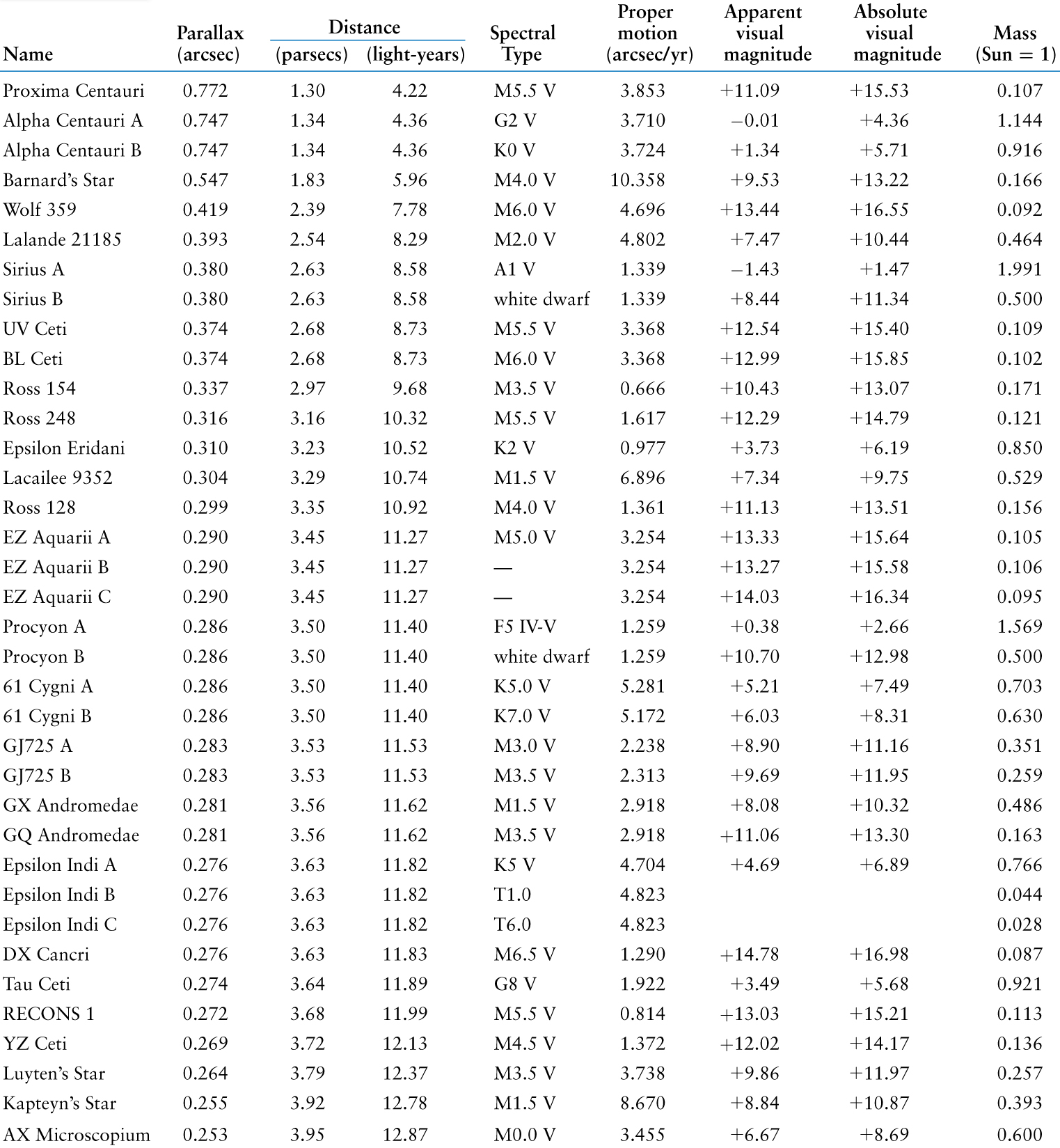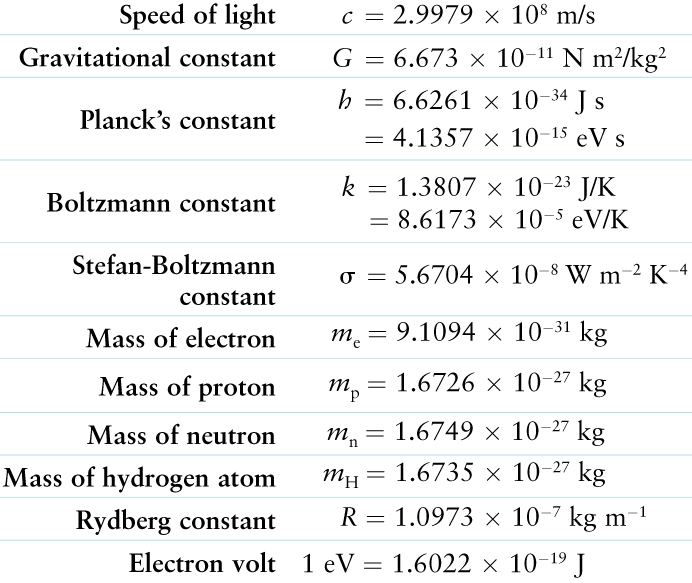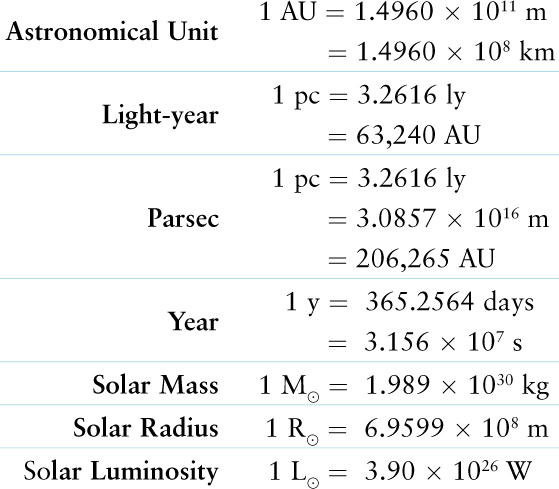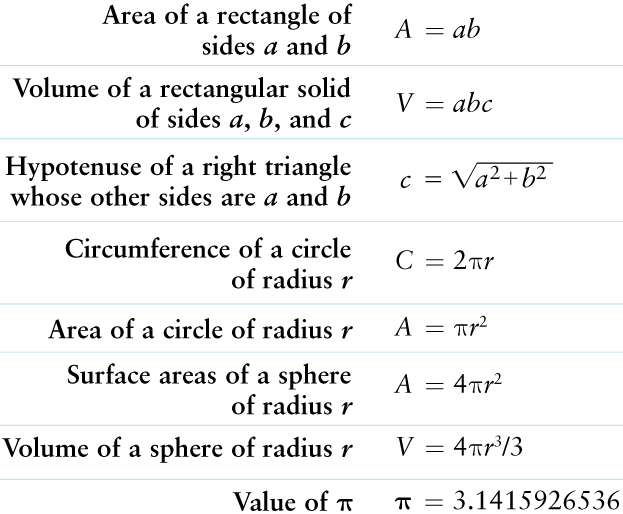Appendices
Appendix 1 The Planets: Orbital Data

Appendix 2 The Planets: Physical Data

*For Jupiter, Saturn, Uranus, and Neptune, the internal rotation period is given. A superscript R means that the rotation is retrograde (opposite the planet’s orbital motion).
| Planet | Satellite | Date of discovery | Average distance from center of planet (km) | Orbital (sidereal) period (days)* | Orbital eccentricity | Size of satellite (km)** | Mass (kg) |
|---|---|---|---|---|---|---|---|
| EARTH | Moon | — | 384,400 | 27.322 | 0.0549 | 3476 | 7.349 × 1022 |
| MARS | Phobos | 1877 | 9378 | 0.319 | 0.01 | 28 × 23 × 20 | 1.1 × 1022 |
| Deimos | 1877 | 23,460 | 1.263 | 0.00 | 16 × 12 × 10 | 1.1 × 1022 | |
| JUPITER | Ganymede | 1610 | 1,070,000 | 7.155 | 0.0011 | 5268 | 1.482 × 1023 |
| Callisto | 1610 | 1,883,000 | 16.689 | 0.0074 | 4800 | 1.077 × 1023 | |
| Io | 1610 | 421,600 | 1.769 | 0.0041 | 3642 | 8.932 × 1022 | |
| Europa | 1610 | 670,900 | 3.551 | 0.0094 | 3120 | 4.791 × 1022 | |
| Himalia | 1904 | 11,461,000 | 250.56 | 0.1623 | 184 | 6.7 × 1018 | |
| Amalthea | 1892 | 181,400 | 0.498 | 0.0031 | 270 × 200 × 155 | 2.1 × 1018 | |
| Elara | 1905 | 11,741,000 | 259.64 | 0.2174 | 78 | 8.7 × 1017 | |
| Thebe | 1979 | 221,900 | 0.675 | 0.0177 | 98 | 1.5 × 1018 | |
| Pasiphaë | 1908 | 23,624,000 | 743.63R | 0.4090 | 58 | 3.0 × 1017 | |
| Carme | 1938 | 23,404,000 | 734.17R | 0.2533 | 46 | 1.3 × 1017 | |
| SATURN | Titan | 1655 | 1,221,870 | 15.95 | 0.0288 | 5150 | 1.34 × 1023 |
| Rhea | 1672 | 527,070 | 4.518 | 0.001 | 1528 | 2.3 × 1021 | |
| Iapetus | 1671 | 3,560,840 | 79.33 | 0.0283 | 1472 | 2.0 × 1021 | |
| Dione | 1684 | 377,420 | 2.737 | 0.0022 | 1123 | 1.1 × 1021 | |
| Tethys | 1684 | 294,670 | 1.888 | 0.0001 | 1066 | 6.2 × 1020 | |
| Enceladus | 1789 | 238,040 | 1.37 | 0.0047 | 504 | 1.1 × 1020 | |
| Mimas | 1789 | 185,540 | 0.942 | 0.0196 | 397 | 3.8 × 1019 | |
| Phoebe | 1898 | 12,947,780 | 550.31R | 0.1635 | 230 × 220 × 210 | 8.3 × 1018 | |
| Hyperion | 1848 | 1,500,880 | 21.28 | 0.0274 | 360 × 280 × 225 | 5.7 × 1018 | |
| Janus | 1980 | 151,460 | 0.695 | 0.0068 | 193 × 173 × 137 | 1.9 × 1018 | |
| URANUS | Titania | 1787 | 436,300 | 8.706 | 0.0011 | 1578 | 3.53 × 1021 |
| Oberon | 1787 | 583,500 | 13.46 | 0.0014 | 1522 | 3.01 × 1021 | |
| Ariel | 1851 | 190,900 | 2.52 | 0.0012 | 1158 | 1.35 × 1021 | |
| umbriel | 1851 | 266,000 | 4.144 | 0.0039 | 1169 | 1.2 × 1021 | |
| Miranda | 1948 | 129,900 | 1.413 | 0.0013 | 471 | 6.59 × 1019 | |
| Puck | 1985 | 86,000 | 0.762 | 0.0001 | 162 | 2.9 × 1018 | |
| Sycorax | 1997 | 12,179,000 | 1288.3R | 0.5224 | 150 | 5.4 × 1018 | |
| Portia | 1986 | 66,100 | 0.513 | 0.0001 | 156 × 126 | 1.7 × 1018 | |
| Juliet | 1986 | 64,400 | 0.493 | 0.0007 | 150 × 74 | 5.6 × 1017 | |
| Belinda | 1986 | 75,300 | 0.624 | 0.0001 | 128 × 64 | 3.6 × 1017 | |
| NEPTUNE | Triton | 1846 | 354,800 | 5.877R | 0 | 2706 | 2.15 × 1022 |
| Proteus | 1989 | 117,647 | 1.122 | 0.0005 | 440 × 416 × 404 | 4.4 3 1019 | |
| Nereid | 1949 | 5,513,400 | 360.14 | 0.7512 | 340 | 3.1 × 1019 | |
| Larissa | 1989 | 73,548 | 0.555 | 0.0014 | 216 × 204 × 164 | 4.2 × 1018 | |
| Galatea | 1989 | 61,953 | 0.429 | 0 | 204 × 184 × 144 | 2.1 × 1018 | |
| Despina | 1989 | 52,526 | 0.335 | 0.0002 | 180 × 150 × 130 | 2.1 × 1018 | |
| Thalassa | 1989 | 50,075 | 0.311 | 0.0002 | 108 × 100 × 52 | 3.5 × 1017 | |
| Naiad | 1989 | 48,227 | 0.294 | 0.0004 | 96 × 60 × 52 | 1.9 × 1017 | |
| Halimede | 2002 | 15,728,000 | 1879.71R | 0.5711 | 62 | 1.8 × 1017 | |
| Neso | 2002 | 22,422,000 | 2914.07 | 0.2931 | 44 | 6.3 × 1016 | |
| This table was compiled from data provided by the Jet Propulsion Laboratory. | |||||||
| *A superscript R means that the satellite orbits in a retrograde direction (opposite to the planet’s rotation). | |||||||
| **The size of a spherical satellite is equal to its diameter. | |||||||
Appendix 4 The Nearest Stars

This table, compiled from data reported by the Research Consortium on Nearby Stars, lists all known stars within 4.00 parsecs (13.05 light-years).
*Stars that are components of multiple star systems are labeled A, B, and C.
Appendix 5 The Visually Brightest Stars

Data in this table were compiled from SIMBAD database operated at the Centre de Donnees Astronomiques de Strasbourg, France.
*A positive radial velocity means that the star is receding; a negative radial velocity means that the star is approaching.
**This is a ratio of the star’s apparent brightness to that of Sirius, the brightest star in the night sky.
Note: Acrux, or α Cru (the brightest star in Crux, the Southern Cross) appears to the naked eye as a star of apparent magnitude +0.87, the same as Aldebaran. However, it does not appear in this table because Acrux is actually a binary star system. The blue-white component stars of this binary system have apparent magnitudes of +1.4 and +1.9, and so they are dimmer than any of the stars listed here.
Appendix 7 Some Important Physical Constants

Appendix 6 Some Important Astronomical Quantities

Appendix 8 Some Useful Mathematics
